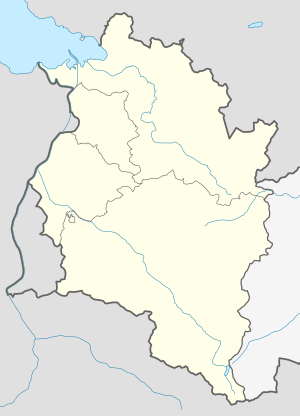Gschwendtobel Bridge
Coordinates: 47 ° 26 '46 " N , 9 ° 55' 42" E
| Gschwendtobel Bridge | ||
|---|---|---|
| The Gschwendtobel Bridge as seen from the Subersach . | ||
| use | Transport, pedestrians | |
| Convicted | Subersach | |
| place | Egg , Lingenau | |
| Entertained by | Municipalities of Egg and Lingenau | |
| construction | Wood | |
| overall length | 41 m | |
| width | 5.30 m | |
| Number of openings | 1 | |
| start of building | 1833 | |
| completion | 1836 | |
| opening | 1836 | |
| Status | receive | |
| planner | Alois Negrelli from Moldelbe | |
| location | ||
|
|
||
| Above sea level | 600 m above sea level A. | |
The Gschwendtobel Bridge (also popularly known as the Negrelli Bridge ) is a covered wooden bridge over the Subersach in Gschwendtobel between the communities of Egg and Lingenau in the Bregenz Forest in Vorarlberg . The bridge planned by civil engineer Alois Negrelli von Moldelbe is considered to be the first suspension bridge to be self-supporting by means of a truss. The bridge is under monument protection ( list entry ).
history
For many centuries the gorge of the Bregenz Ach and the Subersach was a barrier between the front and rear of the Bregenzerwald that was difficult to overcome , which is why different dialects developed in both parts of the country. Towards the end of the 18th century, the desire in the Bregenzerwald for a passable connection between the front and the rear of the Bregenzerwald increased. The original route crossed the Subersach at the site of today's Dahtsteg. Renovation work on the road could not significantly improve the gradient in the Subersach valley. In the 1820s and 1830s, numerous roads and paths were built or expanded in the Bregenzerwald, including the connection between Großdorf and Lingenau. Alois Negrelli, from 1825 to 1832 district hydraulic engineering adjunct in Vorarlberg, was commissioned with the alignment of the road from Großdorf to Lingenau. Due to the bad experience with the original route, the route was relocated towards the Gschwendtobel. The connection was built between 1833 and 1836 under the direction of the Egger community leader Johann Berlinger . Negrelli planned the road through the Gschwendtobel with a maximum gradient of 9%. For the construction of the road, residents of several Bregenzerwald communities were called upon to do “labor”. The proportion of working hours per municipality was determined based on the population. The work performed according to the municipal regulations was paid out in cash. The municipality of Egg assumed the costs of building the Gschwendtobel bridge. Road construction on the Eggs side was financed by the municipalities of the Inner Bregenz Forest. The Vorderbregenzerwald took over the costs of the road construction on the Lingenau side as well as the construction of the northern bridgehead. The wood originally used for the bridge was felled between 1828 and 1836.
Due to landslides and subsidence of the route, the road had to be renovated and repaired over the years. The bridge has also been improved several times.
For many decades, the route over the Gschwendtobel Bridge was the most important road link between the Front and the Rear Bregenzerwald and an important link between the Bregenzerwald and Germany . It was only with the opening of the Lingenau high bridge in 1969 and the construction of the new Gschwendtobel bridge in 1982 that the covered wooden bridge over the Subersach lost its importance as a traffic route.
The municipalities of Egg and Lingenau have been responsible for maintaining the old, listed Gschwendtobel Bridge since 1980.
architecture
The load-bearing structure of the bridge is designed as a triple-reinforced hanging truss . The horizontal beams rest on both sides of the roadway on the explosive struts. These in turn are supported by the foundations on the river bank. The roof structure rests on the horizontal beams. In addition, the roadway is suspended from the beams. A board wall on both sides of the bridge and an Eternit roof protect the bridge's construction from the elements. The board wall closes downwards in a segmental arc. Both sides of the bridge are pierced by light openings.
The bridge structure is 41 meters long, 5.3 meters wide and is twelve meters above the average water surface of the Subersach. Mostly silver fir wood was used for construction .
literature
- Gschwendtobel Bridge. In: Dehio manual. The art monuments of Austria. Topographical inventory of monuments published by the Federal Monuments Office . edited in the Department for Monument Research, formerly: Institute for Austrian Art Research. Vorarlberg. Edited by Gert Ammann , Martin Bitschnau , Paul Rachbauer , Helmut Swozilek . Verlag Anton Schroll & Co , Vienna 1983, ISBN 3-7031-0585-2 , p. 291 ( Dehio Vorarlberg 1983 )
- Rudolf Berchtel: Bregenzerwald hiking book. Innsbruck 2009, Tyrolia Verlag , ISBN 978-3-7022-2996-2 , p. 44
Web links
Individual evidence
- ↑ Gschwendtobelbrücke on the lingenau.at page (accessed on May 4, 2020)
- ↑ a b c d "History of the Gschwendtobel Bridge " on Tannenland Travel Guide (accessed on May 3, 2020)
- ↑ a b "Quelltuffweg" in alpen-guide.de (accessed on May 3, 2020)
- ↑ "Gschwendtobelbrücke, Lingenau / Egg" on travel guide Tannenland (accessed on May 3, 2020)
- ↑ Gschwendtobel Bridge on the Vorarlberg Tourismus website (accessed on May 3, 2020)
- ↑ Gschwendtobel Bridge on wegezumholz.de (accessed on May 3, 2020)


